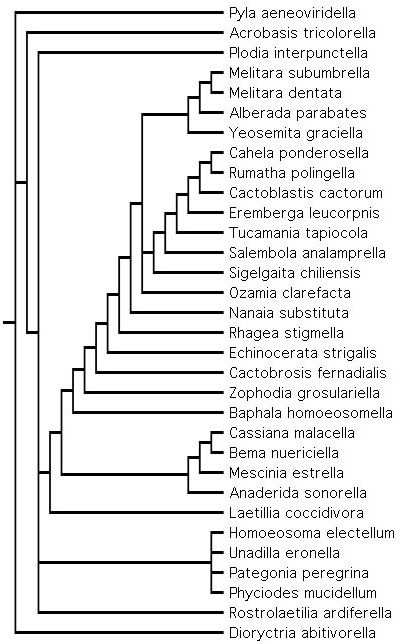Phylogenetic Relationships
Simonsen (2008) presented a phylogeny of 20 taxa of cactus-feeders sensu lato (including Rostrolaetilia, Laetilia, Baphala, Rhagea and Zophodia), with four genera from the Mescinia group (Mescinia, Anderida, Bema, Cassiana) and four genera from the Homoeosoma group (Homoeosoma, Patagonia, Unadilla, Phyciodes) as near out groups, and four additional phycitine genera (Pyla, Plodia, Dioryctria, Acrobasis) as far out groups. The study was based solely on adult morphology, and though the resulting strict consensus tree was well resolved (see below), it was also poorly supported. The results were therefore considered preliminary. However, several important conclusions were drawn based on the results. First of all, the cactus-feeder group including Rostrolaetilia and Laetilia was not recovered as monophyletic, and it was concluded that Rostrolaetilia probably is only distantly related to the remainder of the in group. Laetilia, the remaining cactus-feeders, and the Mescinia group did for a monophyletic group, as did the cactus-feeders excluding Rostrolaetilia and Laetilia. Within the cactus-feeders, Melitara dentata and Melitara subumbrella (formerly Olycella) formed a well-supported clade, thus supporting Neunzig’s (1997) synonymization of Olycella with Melitara. The two dominant North American genera Alberada and Melitara formed the strongest supported clade in the analysis, thus supporting a close relationship between the two suggested by both Heinrich (1939, 1956) and Neunzig (1997). Surprisingly, Cactoblastis was found to be only distantly related to the Melitara-Alberada clade despite the overall similarities between the three genera. Though the latter result especially is somewhat uncertain, preliminary molecular studies headed by A. D. Roe and T. J. Simonsen seem to confirm the quite distant relationship between Cactoblastis and Melitara (unpublished), as well as the overall monophyly of the cactus-feeders including the gooseberry-feeder Zophodia. Finally, Simonsen (2008) concluded that the cactus-feeding larva had a single origin, but a host plant shift had happened in the lineage leading to the Crassulaceae-feeding genus Rhagea.

Consensus tree of cactus-feeding Phycitinae and their relatives.

